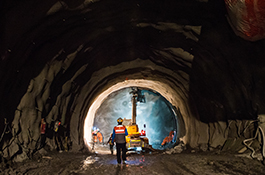James Marzocca, Hatch’s Managing Director, Project Management & Construction: “Our business is fraught with safety risks and hazards, especially at the sites of our clients’ operations and projects. So it should surprise no one that a strong record of safety performance is a major factor in being selected as a service provider. Clients want to know that we can keep our staff, contractors, existing operations, and their businesses safe while doing the work they’ve hired us to do.
“How a service provider’s safety performance is measured may vary from one company to the next. Generally, clients look at a combination of its historical safety performance, the safety culture in the organization, and the quality of safety systems. Their yardstick is usually two ‘lagging indicators’: lost time injury frequency rates (LTIFR) and total reportable injury frequency rates (TRIFR). Our performance on these lagging indicators has been enviable and improving over the years. Hatch remains in the first quartile (top 25%) for EPCM service providers in the industry as measured by the Construction Industry Institute.
“Good performances can always be better. A company’s ambition should be to continuously improve its safety performance. Our vision is to be in the top 10% in our industry. To achieve this, we must constantly be trying to improve our safety performance and finding ways to manage that improvement. We need to be always bettering the behaviors and focuses of our people, our partners, our contractors, and yes, even our clients. Doing this means watching and measuring what we do on the “input side” or “leading indicators” of safety. Leading indicators are measures of things that contribute to safety, such as visible leadership, the reporting of unsafe acts and conditions and having them fixed promptly, safety training attendance and comprehension, safety audits, and participation in safety events.
“Information sharing plays a huge part in improving safety performance. All parties in the industry—clients, service providers, equipment vendors, fabricators, government agencies, providers of safety equipment, and contractors—can learn from one another. Those lessons can be used to prevent or mitigate incidents.
“For this reason, starting in 2018, Hatch will host an annual industry-wide safety conference in Toronto, Canada. Its purpose will be to bring members of all these groups together to share information, learnings, and best practices.
“The safety conference will also encourage participants to share how technology can be used to create safer work environments, especially on projects. The industry already makes the most of several technologies, practices and initiatives to improve safety performance. The value of PPE, modularization and preassembly, the automation of construction tasks, safety training, toolbox talks, job-safety analysis, and more are well documented.
“There are many more new and emerging technologies that can improve safety even further still. Digital technologies, drones, HD cameras, sensors, safer materials, training and behavioral sciences, improved tracking of people and equipment, and the use of virtual reality are still in their infancy, awaiting adoption in the safety sphere. What is already very mature, however, is the capability that all these have to create continuous improvement or step change in safety performance.
“A projects’ success—financial or otherwise—can never come at the cost of a worker’s safety. This is a fundamental value that every conscientious organization embraces on the journey to zero harm. There may not be one sole solution for improving safety. Still, this we know for sure: our behaviour, the sharing of information, understanding and mitigating safety risks, and the use of technology all have an important part to play in fostering a strong safety culture and improving safety performance.”
The picture shows work on the Chuquicamata underground mine in Chile, a project in which Hatch is very involved.










